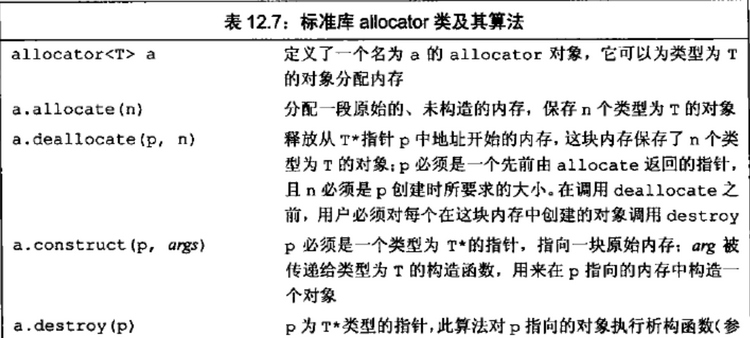how to work with FlatBuffers std::allocator
flat_buffer - 1.70.0 https://www.boost.org/doc/libs/1_70_0/libs/beast/doc/html/beast/ref/boost__beast__flat_buffer.html
FlatBuffers: Use in C++ https://flatbuffers.dev/flatbuffers_guide_use_cpp.html
FlatBuffers: Tutorial https://flatbuffers.dev/flatbuffers_guide_tutorial.html
std::allocator() in C++ with Examples - GeeksforGeeks https://www.geeksforgeeks.org/stdallocator-in-cpp-with-examples/
Allocators are objects responsible for encapsulating memory management. std::allocator is used when you want to separate allocation and do construction in two steps. It is also used when separate destruction and deallocation is done in two steps. All the STL containers in C++ have a type parameter Allocator that is by default std::allocator. The default allocator simply uses the operators new and delete to obtain and release memory. Declaration :
template <class T> class allocator;
Member functions associated with std::allocator() :
- address: It is used for obtaining the address of an object although it is removed in C++20.
- construct: It is used to construct an object.It is also removed in C++20.
- destroy: It is used to destruct an object in allocated storage.It is also removed in C++20.
- max_size: It returns the largest supported allocation size.It is deprecated in C++17 and removed in C++20.
- allocate: Used for allocation of memory.
- deallocate: Used for deallocation of memory.
C++中std::allocator的使用-CSDN博客 https://blog.csdn.net/fengbingchun/article/details/78943527
标准库中包含一个名为allocator的类,允许我们将分配和初始化分离。使用allocator通常会提供更好的性能和更灵活的内存管理能力。
new有一些灵活性上的局限,其中一方面表现在它将内存分配和对象构造组合在了一起。类似的,delete将对象析构和内存释放组合在了一起。我们分配单个对象时,通常希望将内存分配和对象初始化组合在一起。因为在这种情况下,我们几乎肯定知道对象应有什么值。当分配一大块内存时,我们通常计划在这块内存上按需构造对象。在此情况下,我们希望将内存分配和对象构造分离。这意味着我们可以分配大块内存,但只在真正需要时才真正执行对象的创建操作(同时付出一定开销)。一般情况下,将内存分配和对象构造组合在一起可能会导致不必要的浪费。
标准库allocator类定义在头文件memory中,它帮助我们将内存分配和对象构造分离开来。它提供一种类型感知的内存分配方法,它分配的内存是原始的、未构造的。类似vector,allocator是一个模板。为了定义一个allocator对象,我们必须指明这个allocator可以分配的对象类型。当一个allocator对象分配内存时,它会根据给定的对象类型来确定恰当的内存大小和对齐位置。allocator支持的操作,如下:

allocatro分配的内存是未构造的(unconstructed)。我们按需要在此内存中构造对象。在新标准库中,construct成员函数接受一个指针和零个或多个额外参数,在给定位置构造一个元素。额外参数用来初始化构造的对象。类似make_shared的参数,这些额外参数必须是与构造的对象的类型相匹配的合法的初始化器。
在早期版本的标准库中,construct只接受两个参数:指向创建对象位置的指针和一个元素类型的值。因此,我们只能将一个元素拷贝到未构造空间中,而不能用元素类型的任何其它构造函数来构造一个元素。还未构造对象的情况下就使用原始内存是错误的。为了使用allocator返回的内存,我们必须用construct构造对象。使用未构造的内存,其行为是未定义的。
当我们用完对象后,必须对每个构造的元素调用destroy来销毁它们。函数destroy接受一个指针,对执行的对象执行析构函数。我们只能对真正构造了的元素进行destroy操作。一旦元素被销毁后,就可以重新使用这部分内存来保存其它string,也可以将其归还给系统。释放内存通过调用deallocate来完成。我们传递给deallocate的指针不能为空,它必须指向由allocate分配的内存。而且,传递给deallocate的大小参数必须与调用allocate分配内存时提供的大小参数具有一样的值。
标准库还为allocator类定义了两个伴随算法,可以在未初始化内存中创建对象。它们都定义在头文件memory中,如下:

在C++中,内存是通过new表达式分配,通过delete表达式释放的。标准库还定义了一个allocator类来分配动态内存块。分配动态内存的程序应负责释放它所分配的内存。内存的正确释放是非常容易出错的地方:要么内存永远不会被释放,要么在仍有指针引用它时就被释放了。新的标准库定义了智能指针类型------shared_ptr、unique_ptr和weak_ptr,可令动态内存管理更为安全。对于一块内存,当没有任何用户使用它时,智能指针会自动释放它。现代C++程序应尽可能使用智能指针。
std::allocator是标准库容器的默认内存分配器。你可以替换自己的分配器,这允许你控制标准容器分配内存的方式。
以上内容主要摘自:《C++Primer(Fifth Edition 中文版)》第12.2.2章节




 浙公网安备 33010602011771号
浙公网安备 33010602011771号